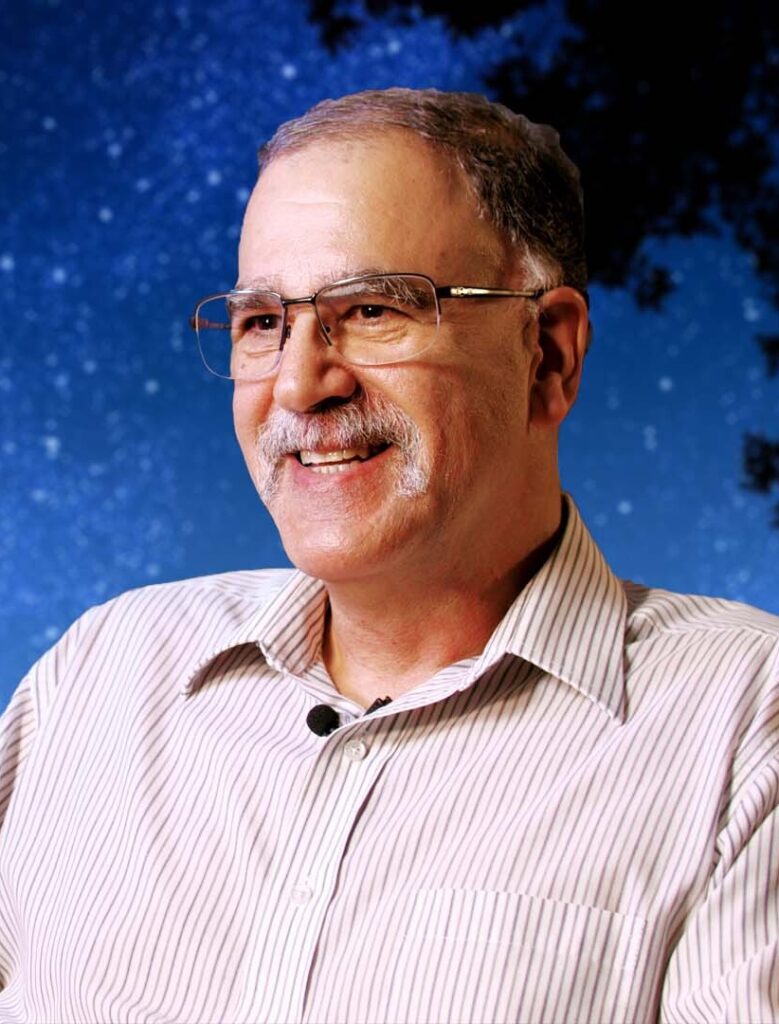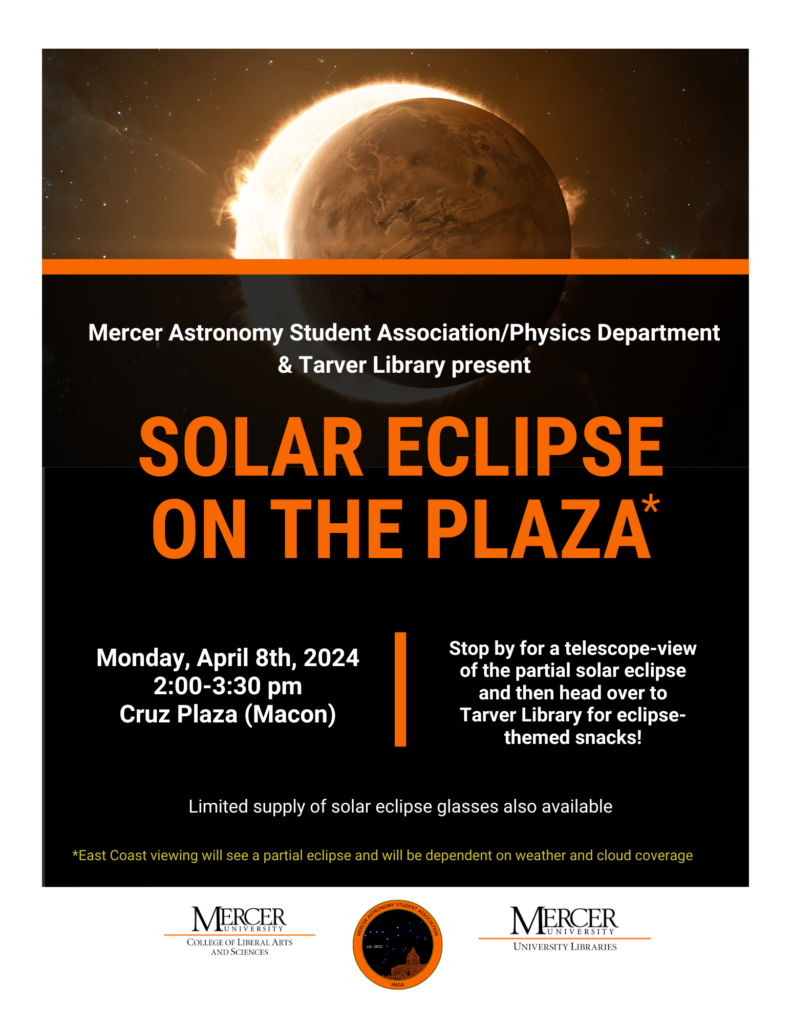A total solar eclipse will sweep across North America on April 8, and some Mercerians are teaming up to help others observe it safely and understand the science behind it. Viewing parties will be hosted on the Macon and Atlanta campuses that afternoon, and an educational video created by Mercer University faculty and students will be shared on a federal website.
During a solar eclipse, the moon passes between the Earth and the sun, casting a shadow on the Earth. When it’s a total solar eclipse, the moon fully covers the sun for a short time, with just the haze of the sun’s corona — the outermost layer of the sun’s atmosphere — visible around it, said physics professor Dr. Matt Marone. Solar eclipses occur during a new moon, when the moon is on the same side of the Earth as the sun.

“You might think that (an eclipse) would occur every month when there is a new moon, but it doesn’t because the plane of the Earth’s orbit and the plane of the moon’s orbit around the Earth are not parallel,” Dr. Marone said. “The moon’s orbit is slightly at an angle to the Earth’s orbit. We don’t get an eclipse every single time because the shadow is not pointing directly onto some location on the earth.”
The United States last had a coast-to-coast total solar eclipse on Aug. 21, 2017, with the path of totality crossing from Portland, Oregan, to Charleston, South Carolina. This time, weather permitting, the totality path will stretch from Mexico into Texas and all the way up through Maine into Canada, according to NASA. A comet called 12P/Pons-Brooks may also be visible in these areas of totality. A partial eclipse should be visible throughout the rest of the contiguous United States, including Georgia. Explore the path of totality here.
The eclipse will reach about 70% totality in Macon, taking on a crescent moon-like shape. The shadow will begin to touch the moon around 1:45 p.m.; peak eclipse will be reached around 3 p.m.; and the event will conclude around 4:20 p.m., Dr. Marone said. Observers can expect the temperature to drop quite a bit as the sun is blocked.
To view the solar eclipse safely by the naked eye and avoid eye injury, eclipse glasses or a handheld solar viewer must be used. Solar filters are necessary if observing through a camera lens, binoculars or telescopes. If these tools aren’t available, the eclipse can be viewed indirectly by creating a pinhole projector.
Eclipse glasses are difficult to find right now, but Bears on our Macon and Atlanta campuses can gather together to view the solar eclipse safely on April 8. In Macon, a viewing party will be held on Cruz Plaza from 2-3:30 p.m. The event is being hosted by the physics department, Tarver Library and Mercer Astronomy Student Association, and multiple telescopes with solar filters and a big screen TV to project images will be set up. A limited supply of eclipse glasses will also be on hand, Dr. Marone said.

Lee Twombly Olson, head of research services at Tarver, said the viewing party is a way to promote a fun event, collaborate with other Mercer departments, and cultivate a sense of community.
Bears on the Atlanta campus can watch the eclipse from the bridge in front of Swilley Library, where eclipse glasses will be available. The Atlanta and Macon libraries and the libraries at the Douglas and Henry County regional academic centers will also be handing out Moon Pies and SunChips.
To help people better understand and prepare for the eclipse on April 8, Dr. Marone; Dr. Philip Gallagher, assistant professor of technical communication; and student Joshua Slaton have created an educational video (see top of story) that will be published on the website of the Global Learning and Observations to Benefit the Environment (GLOBE) Program, along with other eclipse resources. Some of Dr. Marone’s solar eclipse simulation videos have also been shared on this site.
Citizen scientists across the world can make and submit environmental measurements, including for events like the upcoming solar eclipse, through GLOBE, which is sponsored by the National Science Foundation, National Oceanic and Atmospheric Administration, U.S. Department of State and NASA. Students at the Georgia Academy for the Blind have submitted observations in the past using an accessible device created by Dr. Marone and will take temperature and humidity readings on April 8, Dr. Marone said.

“GLOBE emphasizes citizen science, aiming to foster astronomical interest among people of all ages,” Dr. Gallagher said. “Our role in sharing information and engaging in educational outreach is vital, contributing not only to science education but also to cultural and historical understanding. The eclipse provides a unique chance to learn about astronomy, scientific phenomena, cultural interpretations, and human traditions spanning centuries. Collaborating with GLOBE for an educational eclipse video presents a valuable learning opportunity for schools, museums and the public, as well as our students.”
The video is aimed at K-12 audiences and was made using Starry Night 8, Canva Pro, Voicemod, and Final Cut Pro software, Dr. Gallagher said. Dr. Marone served as the space simulations expert, Slaton as the designer and prototype engineer, Dr. Gallagher as producer and director, and technical communication assistant professor Dr. Bremen Vance as design consultant. Marci Gallagher, a Master of Family Therapy student and Dr. Gallagher’s partner, provided voiceover work, and music professor Dr. Monty Cole contributed the music.
“Between the fantastic team and resources, everything came together to make a fun, approachable, and educational video for the upcoming eclipse event that both teaches, tells a story, and seeks to promote a safe viewing experience for everyone,” Dr. Gallagher said. “We worked hard to not only help viewers learn about eclipses but also learn about how to practice eclipse safety and protect their vision. This is especially important with young scientists and people who are excited to take photos and videos of the eclipse.”








